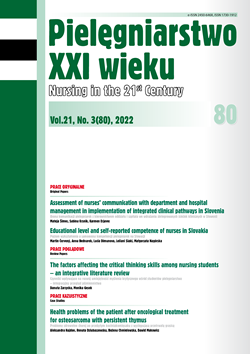Women’s problems associated with pelvic fl oor muscle dysfunction
DOI:
https://doi.org/10.2478/pielxxiw-2022-0020Keywords:
woman, pelvic fl oor muscle, dysfunctionAbstract
WOMEN’S PROBLEMS ASSOCIATED WITH PELVIC FLOOR MUSCLE DYSFUNCTION
Introduction. Pelvic fl oor muscle dysfunction is a common condition caused by failure of the suspensory and support apparatus, resulting in lowering of the vaginal walls and pelvic organs. They aff ect nearly half of all peri- and postmenopausal women. In recent years, the role of pelvic fl oor muscles has received increasing attention in both clinical trials and other studies.
Aim. Presentation of women’s problems associated with pelvic fl oor muscle dysfunction.
Methods. A review of the literature in Polish and English on pelvic fl oor dysfunction. Scholarly and professional publications covering 2015-2020 were searched in databases: EBSCO HOST, CINAHL, MEDLINE, and PubMed using keywords.
Results. Pelvic fl oor muscle dysfunction is a common condition caused by failure of the suspensory and support apparatus, resulting in lowering of the vaginal walls and pelvic organs. They aff ect nearly half of peri- and postmenopausal women.
Summary. Considering how many women face a variety of complaints related to pelvic fl oor dysfunction, it is imperative that health care professionals are properly prepared to educate patients about the anatomy, physiology, and pathology of pelvic fl oor muscles.
References
1. Nawrot J, Humaj-Grysztar M, Gniadek A, i wsp. Jakość życia kobiet z zaburzeniami statyki narządu rodnego w wieku pomenopauzalnym. Piel XXI wieku. 2017;4(6): 20-23.
2. Skrzypulec-Plinta V, Sadłocha M. Raport Polki 50 plus. Zdrowie i jego zagrożenia. 2015: 80-81.
3. Baranowski W, Rogowski A. Uroginekologia. Medical Tribune Polska, 2018.
4. Neumann P, Gill V. Pelvic Floor and Abdominal Muscle Interaction: EMG Activity and Intra-abdominal Pressure.Springer-Verlag Limited Int Urogynecol J. 2002; 13:125132.
5. DeLancey JOL. Anatomic aspects of vaginal eversion after hysterectomy. Am J ObstetGynecol. 1992; 166: 1717-1724.
6. Maziarska MA, Mościan W, Sobolewska A, i wsp. Nietrzymanie moczu jako narastający problem społeczny. Piel ZdrPubl. 2020; 10(4): 1-6.
7. Berghmas B. Physiotherapy for pelvic pain and female sexual dysfunction: an untapped resource. International Urogynecology Journal. 2018; 29(5): 631-638.
8. Naliboff BD, Stephens AJ, Afari N, et al. MAPP Research Network: Widespread Psychosocial Difficulties in Men and Women With Urologic Chronic Pelvic Pain Syndromes: Case-control Findings From the Multidisciplinary Approach to the Study of Chronic Pelvic Pain Research Network. Urology. 2015; 85(6):1319-1327.
9. Lahaire MA, Amsel R, Khalifé S, et al. Can Fear, Pain, and Muscle Tension Discriminate Vaginismus from Dyspareunia/Provoked Vestibulodynia? Implications for the New DSM-5 Diagnosis of Genito-Pelvic Pain/Penetration Disord. Arch Sex Behav. 2015; 44(6): 1537-1550.
10. Kinsey AC, Pomeroy WB, Martin CF, et al. Sexual behawior in the human female. Saunder, Philadelphia, 1953.
11. Szymanowski P, Szweda H, Szepieniec WK, i wsp. Rola defektu apikalnego w patogenezie obniżenianarządów miednicy mniejszej: cystocele z defektem apikalnym. Państwoi Społeczeństwo. 2017; 4: 9-20.
12. Preda A, Moreira S. Stress Urinary Incontinence and Female Sexual Dysfunction: The Role of Pelvic Floor Rehabilitation. Acta Med Port. 2019; 4; 32(11): 721-726.
13. Reider B. Role of Pelvic Floor Muscles in Female Orgasmic Response. Journal Womens Health, Issues&Care. 2016; 5(6): 2-6.
14. Wallace SLA, Miller, Lucia DB, et al. Pelvic floor physical therapy in the treatment of pelvic floor dysfunction in women. Urogynecology. 2019; 6(31): 485-493.
15. Hlavinka TC, Turčan P, Bader A. The Use of HIFEM Technology in the Treatment of Pelvic Floor Muscles as a Cause of Female Sexual Dysfunction: A Multi-Center Pilot Study. Journal Women’s Health Care. 2019; 8: 1.
16. Sacomori C, Virtuoso JF, Kruger AP. Pelvic floor muscle strength and sexual function in women. Fisioterapia Em Movimento. 2015; 28(4): 657-665.
Downloads
Published
Issue
Section
License
Copyright (c) 2022 Authors

This work is licensed under a Creative Commons Attribution 4.0 International License.




